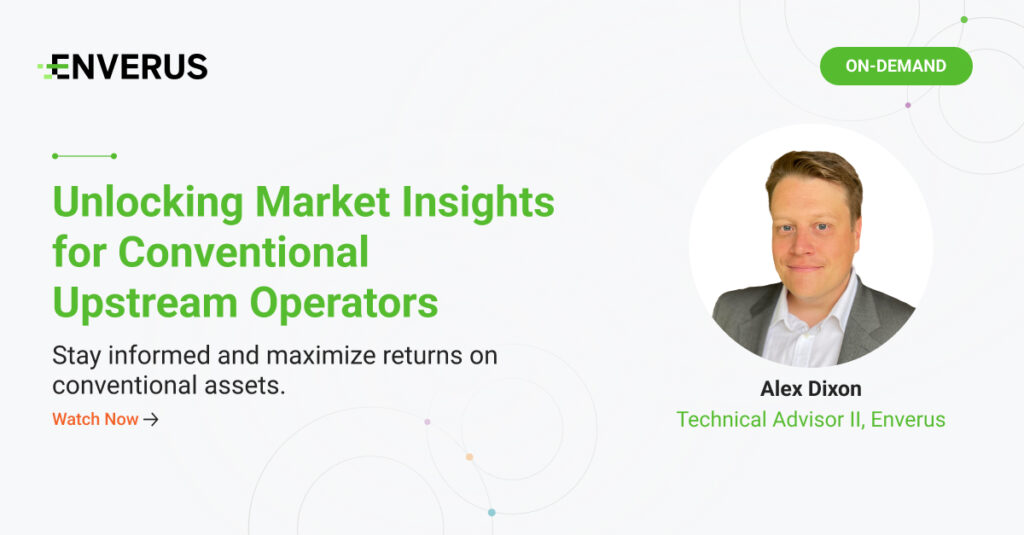What Conventional Oil & Gas Operators Can Learn from the Central Basin Platform Right Now
While unconventional plays often dominate headlines, there’s a quiet confidence building in the Central Basin Platform (CBP). Operators here aren’t chasing hype. They’re managing mature fields with discipline, data and experience—and they’re producing real results.
This blog highlights a few key takeaways from our recent Enverus webinar focused on the CBP. If you’re interested in the full analysis, field-level forecasting and live Enverus PRISM® workflows we covered, you can watch the full webinar here.
So, what did we highlight during the webinar? Well, the short version is that enhanced oil recovery (EOR), water logistics and smart forecasting are redefining what’s possible for conventional assets. It’s not just about squeezing out the last drop. It’s actually about seeing conventional through a new lens.
What You’ll Learn in This Article
- Why the CBP is still a valuable region for conventional oil and gas production.
- How EOR methods like waterflooding and gas injection are being optimized today.
- What operators like Occidental are doing to maintain high-output assets in mature fields.
- How forecasting tools like Forecast Studio help identify upside and manage decline.
- Where acquisition opportunities exist for conventional assets.
- How infrastructure and produced water can be repurposed to unlock new value.
The CBP: Not Quite Past Its Prime
Tucked between the Delaware and Midland Basins, the CBP is often treated like a historical footnote. That’s a mistake.
This region still delivers more than 4.2 million barrels of oil via nearly 28,500 producing wells and 46 million barrels of water every month.
Operators like Occidental are actively maintaining and expanding fields like Hobbs and Seminole, using water and gas injection at scale. These aren’t legacy projects. They’re highly engineered, high-output assets that continue to perform reliably year after year.
Water Is the Workhorse
In unconventional basins, water is often a disposal problem. In the CBP, it’s a production enabler.
EOR operations in the platform rely on efficient waterflood cycles. In Hobbs and Seminole, operators are injecting up to around 12 million barrels of water monthly and recovering nearly the same amount. That near one-to-one ratio is a strong indicator of efficient floodfront movement and well-managed injectors.
Gas injection volumes are equally significant, reaching up to 16 BCF per month across these same fields combined. This dual-cycle EOR strategy demonstrates that conventional doesn’t mean outdated. It means optimized.

From Historical Data to Smart Forecasting
One of the biggest shifts in conventional operations is how data is being used. Not just to look back, but to look forward.
In the webinar, our team used Forecast Studio to run decline curve analysis (DCA) on more than 17,000 CBP wells. This generated field-level forecasts, identified estimated ultimate recovery (EUR), and tracked gas-oil ratios for individual assets.
The insights were clear.
The ratio of oil produced per barrel of water injected has declined from around 14-15% in 2000 to about 7.6% more recently. That kind of trend matters. It doesn’t mean a field is failing. It means there may be room to reevaluate injection strategy, revisit target zones, or optimize operations.
Buying Smarter: M&A Opportunities in Conventional Fields
Another angle that conventional operators should be thinking about is acquisition strategy.
We walked through how PRISM can help evaluate active M&A deals in the CBP and beyond. With tools to visualize producing wells, inactive producers, infrastructure, vintage trends and EUR forecasts, you can quickly assess whether an asset is a fixer-upper or a hidden gem.
Some modest assets showed recoverable gas volumes in the BCF range, even without recent drilling. You can filter for conventional-only listings and run PDP forecasts on the spot. When you can combine production history with surface and subsurface data, you gain a clearer picture of value.
What If You Could Restart an Old Field With New Tools?
Another idea we explored is whether produced water from other Permian zones could be used to support EOR in CBP fields that are under-injected today.
Using pipeline mapping in PRISM, we found that while water pipelines and saltwater disposal systems exist, they may also hold untapped potential. If that water could be redirected to the CBP, it might breathe new life into mature fields that still have productive capacity.
Some fields already have structural integrity and well spacing that could support it. What’s needed now is infrastructure alignment and operational will.
Why All This Matters Right Now
With capital efficiency more important than ever, conventional oil fields offer something that unconventional plays sometimes can’t: predictability, existing infrastructure and decades of data.
When paired with modern analytics like PRISM and Forecast Studio, conventional assets become lower-risk opportunities with clear upside. They aren’t just producing. They’re performing.
If You’re a Conventional Operator, Here’s What to Take Away:
- Your fields still have value. EOR and good management can extend production well into the future.
- Forecasting matters. Knowing your injection ratios, vintages, and decline curves helps you act strategically.
- Smaller deals can pay off. Conventional M&A opportunities often hide in plain sight.
- Infrastructure is key. Pipelines, pads and permits can tell you where to invest or expand.
Want to Keep Exploring?
Here are a few additional reads you might find helpful:
Enverus is here to help you move with clarity, not guesswork. If your team works with conventional oil and gas assets, we’re ready to support your next step.
www.enverus.com (Article Sourced Website)
#Lessons #Central #Basin #Platform #Conventional #Operators
